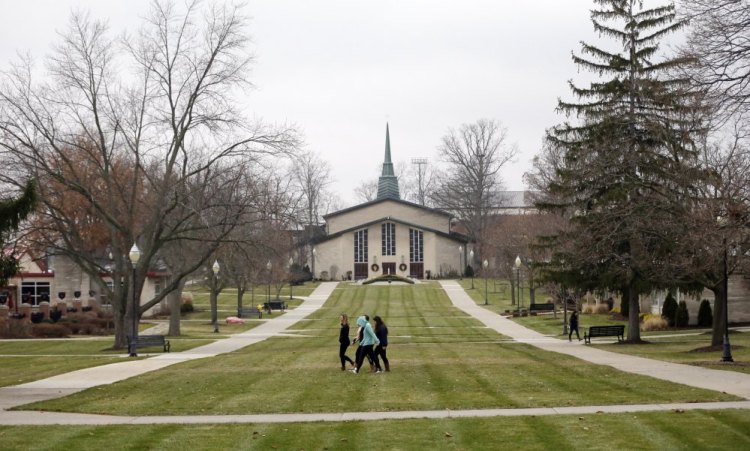ADRIAN, Mich. — When it came time to pick a college, Abby Slusher leaned toward a private school near her home in southeastern Michigan for the small campus and class sizes. Her mother pushed Adrian College for another reason: A new program guaranteeing that every graduate would earn more than $37,000 a year or get some or all student loans reimbursed.
Adrian is among the first colleges to take out insurance policies on all incoming freshmen and transfer students who have student loans and at least two years of school remaining.
“She said, ‘Look at me, I’m still trying to pay my student loans off – this would be great. I don’t want you in this situation,”‘ said Slusher, 18, who is studying to become a social worker. “And seeing her in this situation, I don’t want that.”
The idea has been around for a few decades, at Yale Law School and for specific programs elsewhere, such as seminary and social work degrees.
In Maine, Thomas College in Waterville has a Guaranteed Job Program. It assures students that if they work with the career services office, do their part to find jobs related to their majors and still don’t get jobs, the college will make their federal student loan payments for as long as a year or let them start master’s degree programs for free.
Some small, religious schools started offering guarantees to all new students in recent years, but Adrian President Jeffrey Docking is taking it further by framing the program as a solution to skyrocketing tuition costs and student loan defaults. His crusade has gotten the attention of U.S. lawmakers and education officials.
“Obviously, we feel like this is a big solution to a big problem – maybe the biggest problem right now in higher education,” Docking said. “We felt like we needed to make a grand statement.”
Adrian paid about $575,000 this year, $1,165 per student, to take out policies on 495 students. For those who graduate and get jobs that pays less than $20,000 a year, the college will make full monthly student loan payments until they make $37,000 a year. With jobs that pay $20,000 to $37,000, the college will make payments on a sliding scale.
There’s no time limit for the payment plan, but the college caps total loan payments at $70,000 per student. Adrian’s annual cost of tuition, room and board is about $40,000 before any forms of financial aid.
The school has 1,700 students.
Docking already sees benefits: The entering freshmen class is up about 50 students, to 570; to break even, the school determined it needed about two dozen new students who took out loans. He credits the program in part for the enrollment increase but says other efforts, like launching a varsity bass fishing team, have served as a lure.
About 35 miles northwest of Adrian, Spring Arbor University, a small Christian institution, offered a similar guarantee to every incoming freshman in fall 2013. A conversation with Spring Arbor’s former president inspired Docking.
Although Spring Arbor officials see value in the program, they’re likely to scale it back next year.
“For the vast majority of students, it’s not a deciding factor in choosing Spring Arbor,” said school spokesman Malachi Crane. “Is there a way to better tailor it to students who really need it and have the desire to have that option? For us, it makes more fiscal sense not to automatically assign it to each and every student.”
Both programs were made possible by the Loan Repayment Assistance Program Association, a Bloomington, Indiana-based organization that works with U.S. colleges and universities. Peter Samuelson, the organization’s president, said some schools “have ramped up, ramped back down and ramped back up again” with loan programs, but overall results are positive.
To get word out about the program, Docking met with other university presidents and testified last year before a U.S. House higher education subcommittee. Retiring U.S. Sen. Carl Levin, D-Mich., made a floor statement last June praising Adrian’s program as a model for other colleges.
Docking said federal education officials told him at a meeting in August that they are exploring ways to promote the program. Education Department spokeswoman Denise Horn said officials commend the college for its “creative approach” to helping students manage their loans.
“We’re talking about this far and wide because we hope other colleges do it as well,” Docking said.
Mark Kantrowicz, publisher of edvisors.com, a college planning and financing website, said such programs have grown as school administrators become more concerned about rising discount rates, or the percentage of gross tuition given back to students in the form of grants. He calls it an “arms race in recruiting students,” and schools are trying to find ways to stop the discount rate from increasing.
“Obviously, loan repayment assistance provides assistance after the fact, and that has value,” he said. “But it would be better to charge less in the first place.”
Send questions/comments to the editors.




Success. Please wait for the page to reload. If the page does not reload within 5 seconds, please refresh the page.
Enter your email and password to access comments.
Hi, to comment on stories you must . This profile is in addition to your subscription and website login.
Already have a commenting profile? .
Invalid username/password.
Please check your email to confirm and complete your registration.
Only subscribers are eligible to post comments. Please subscribe or login first for digital access. Here’s why.
Use the form below to reset your password. When you've submitted your account email, we will send an email with a reset code.